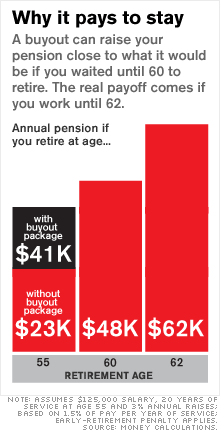Early retirement? Why it pays to stay
Companies are dangling buyouts before older workers, but the packages are rarely enough to support their lifestyles.
 |
| Money Magazine senior writer Janice Revell |

(Money Magazine) -- The job market is looking pretty grim lately. More than 438,000 jobs have been lost already this year, according to the Bureau of Labor Statistics, and companies across a range of industries, from financial services to retail, have been extending early-retirement packages in an effort to slash work forces.
If you're offered such a buyout, you'll face one of the most important financial decisions of your working life: stay on the job or take the money and run.
The enticements you'll get to retire early likely won't offset the drawbacks of spending fewer years at the office. To understand why, you must first understand what you're being offered.
Most retirement buyouts have two parts: severance, usually one or two weeks of pay per year on the job, and a sweetened pension, with as much as five years added to your age and job tenure, says Ethan Kra, retirement actuary at HR consulting firm Mercer.
Say you're 55, earn $125,000 and have been working at your firm for 20 years. Using the most common pension formula - years of service times 1.5%, times your salary - you've earned $37,500 in annual retirement income.
But to collect a full pension, you generally must work until age 62. The younger you are, the more it is reduced. In this example, retire at 55 and you'll get just $22,500, says Kra.
With a buyout, though, your pension would be calculated as if you were 60 and had worked for 25 years, bringing you up to $41,250 a year. That's tempting, especially since you'd earn only a slightly bigger pension ($47,820) if you worked another five years.
Problem is, you can't collect Social Security until you're 62, and you can't support yourself on a pension alone. If you figure you need 80% of your income - or $100,000 - to maintain your lifestyle, you'll start out short by $58,750 a year. And you'll remain short even after Social Security kicks in.
To cover that gap, you'll need to have banked about $1.4 million, says Rande Spiegelman, V.P. of financial planning at the Schwab Center for Financial Research.
Or you can take the package and find another job. But bear in mind: Only 60% of workers age 55 who lose their jobs are re-employed full time within two years, according to consulting firm McKinsey.
If you work a few more years, you can save significantly more. Say you have $500,000 in your 401(k) at age 55. If you add $20,500 a year (the max at your age) for the next seven years, get a 3% match and earn an average of 6% annually on it, you'll have more than $970,000 by 62.
With Social Security and a then $62,300 pension, you'll be able to replace 80% of your salary. What's more, you'll be closer to age 65, when Medicare kicks in, a crucial consideration if your company doesn't have retiree health coverage.
All this math may be meaningless if the early-retirement offer comes at a time when your job is in jeopardy (you've been stripped of duties or received bad reviews) or your company is at risk of going under (its stock has tanked, key clients have fled, budgets have been cut more than usual).
Attractive buyouts can foreshadow forced layoffs with far less generous terms. "When the buyout window shuts," says Kra, "it's usually closed for good."
In that case, take the money. Ask if you can stay on payroll awhile instead of getting severance as a lump sum. That way you'll have health insurance while you look for another job.
To see if you have enough savings, use our Retirement Planner. And given the stakes, talk to your adviser too.
For most workers in their fifties, it makes sense to keep working and keep saving - if you can.
Do you (and your spouse) make more than $170,000 annually and worry about tax-efficient retirement planning? If so, send your name, age, occupation, income and questions, along with a recent photo, to makeover@moneymail.com. We will be providing advice to a family in this situation in an upcoming article - and it could be you! ![]()




